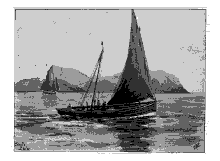More than any types of boat,
those of Holland have been influenced by the peculiar
waters which they navigate ; better than most they
satisfy their peculiar requirements. Indeed, no nation
but the Chinese has had occasion in modern times so
little to alter its accepted types of craft. Three
centuries ago, in lines and in rig, Dutch small craft
were almost the same as they are today. Our own special
types, as such, are almost entirely developments of the
past century, tracing certain peculiarities from older,
rougher, and in general smaller craft, which were their
ancestors, but owing their growth as a distinctive class
to the great increase in coast trade and sea fisheries,
and the unparalleled activity in boat-building which has
been the result. In fact, the consideration of any
sea-going fishing boat in the British Isles will show the
very modern development of the majority of present
British types. The nineteenth century has been an era of
sea-boat building as much as it has been an era of steam.
The small, open, bluff-bowed, roughly rigged
fishing-fleets of the early part of the century, down in
fact to the forties and the fifties, have given place to
large-decked, clean-lined, sea-going fleets, rigged and
equipped with scientific precision ; more powerful, more
speedy, and infinitely more numerous.
But in Holland the requirements of her
internal trade today are almost identical with what they
were centuries ago. The country had reached almost
highest state of agricultural and commercial efficiency
at the beginning of the seventeenth century. Hence while
in England, in the comparative backward state of her
development, the small sailing-vessel was its infancy,
Holland, great in the trade and the councils of the
nations, had developed and perfected her types of craft,
much as she had done her own methods of communication, of
government, and of trade. And to these types, with the
characteristic tenacity of the race, Holland has been
true.
The old Dutch Zee schuyt of the
seventeenth century is familiar to us from the etchings
of Van der Laan, and the wonderful paintings of Van der
Velde the younger, and of Bakhuizen and others of the
great Dutch school of marine painting of the seventeenth
century.
OLD ZEE SCHUYT HAULING NETS
(AFTER VAN DER LAAN)
The pictures of these great artists,
remarkable alike for their wonderful aerial perspectives,
the wide light of their skies, the restraint of their
colouring, and the boldness and accuracy of their
drawing, show that while the present schuyt rig was in
existence at that time, the sprit and squaresail rigs
were very common. The Zee schuyt of the day, probably the
earliest form of herring drift-net fishing-craft, had two
masts, main and mizen.
OLD ZEE SCHUYT, SEVENTEENTH CENTURY
(AFTER VAN DER LAAN)
The latter carried a single
squaresail, which was frequently kept set when riding at
anchor or hauling nets.
OLD SCHEVENINGEN BOAT,
SEVENTEENTH CENTURY
(AFTER VAN RUISDAEL)
The mainmast was usually a pole, but
sometimes carried a topmast. It was placed well back,
even abaft the midship section, in the position rendered
familiar by the old gun-ketches of the beginning of the
nineteenth century. A lower course and square topsail
were set upon it. In this rig we have the precursor of
the schooner-rigged galliot on the one hand, and the
three-masted square-rigged ship on the other.
It will be noted that the fore
triangle with this rig was very large, and from some
early etchings of the period it appears that it was
filled very often by a short foremast with a single
squaresail upon it, as an alternative to large forestay
sail and occasional bowsprit and jib, which seem to have
replaced it by degrees.
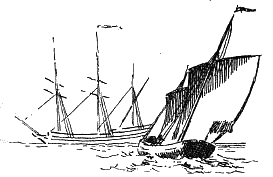 EARLY
LUGSAILS EARLY
LUGSAILS
SEVENTEENTH CENTURY
(AFTER BAKHUIZEN)
The Scheveningen boats of the
time are shown by Van der Velde, rigged with the two
square-rigged masts, but in this case very often the
arrangement of the masts was that of main and fore masts,
the mizen being apparently omitted.
Bakhuizen shows this square rig
without a mizen, and with yards braced round, and tacks
so hauled down forward as to form practically a
lugsail.
The vessels themselves had the round
stern still familiar in Dutch craft. The poop was in
those days higher than we are accustomed to see it. This
high poop, retained to the present day in the seagoing
junk of China, in the dhow and other Eastern craft,
although considered by Western sailors to be ugly and
unshipshape, is in reality a very seamanlike and
convenient provision in any sailing-vessel ; and often
when the writer had it not, he longed for it, and when
had it, he thanked Heaven and the boat-builder for
staunch dry poop whence the vessel could be worked with
some degree of comfort and command when every other part
of the ship was awash.
REEFING SPRITSAIL
(AFTER VAN DER VELDE)
The leeboards of the seventeenth and
eighteenth centuries were of the same shape as those
still in use -- the long, dagger-like board in the
shallow boats, the triangle of the ordinary sea-going
craft, and the almost circular shape of many river
boats.
The clinker build and the wide,
flaring bow and curved stem-piece were the same as at
present, and the tall pole-mast, gay colouring, large,
easy-running blocks, and long vanes have little altered.
The spritsail and the gaff mainsail are the
same.
DAM SCHUYT
(AFTER VAN DER LAAN)
No European type of craft, with the
exception of the open Norse skiff, has such antiquity as
this of the Dutch.
Ruskin in a well-known passage
condones the inaccurate drawing and ignorance of
seamanship displayed in the works of marine artists of
his day by the statement that art which reduplicates art
is necessarily inferior, and that a ship in full sail or
a perfect boat is an 'ignoble subject,' and can never
become the subject of noble art because it is of man's
making.
Yet the exquisite little studies of
Van der Velde, with all their play of light and cloud, of
wind and sea, cannot be surpassed in landscape painting.
They depend for their effect on the accuracy of
delineation of the outline of the wave-cap, the curve of
the sail and spar, the strain of the rope, the heel of
hull, or the direction of swing of an anchored
ship.
OLD DUTCH KETCH
(FROM AN OLD PRINT)
These things tell truly the force and
direction of wind in the picture ; they give the
atmospheric effect which is sought to be expressed ; they
are subject to unalterable laws, and if the artist is
oblivious of them he may as well forget the laws of light
or the law of gravitation. If the human frame must be
studied and drawn with reference to anatomical facts, if
drapery must hang truly, so much the more must the sail
hang furled according to law, or draw and belly truly in
the wind as Nature alone permits it. The sail cannot
swell in untrue curves or fly against the wind, the
sea-caps cannot run counter to it, any more than a
building can stand without foundation or water run up
hill.
OLD SCHUYT
(AFTER VAN DER LAAN)
Many a sail one has seen in pictures
wrongly bent which would blow away or send a vessel stern
first, many a hull wrongly drawn which would infallibly
swamp, or could not have come out of any boat-builder's
shop. This cannot be art, whatever imaginable colouring
it is shrouded in. Van der Velde, using his vessels as
accessories to interpret his thought and to illustrate
the restfulness of calm, or the war and motion of high
winds in the wide tide estuaries of Holland, has never
been surpassed in his expression of atmosphere, sun, and
wind, and this by following the very laws which sea
painters in the nineteenth century so long thought they
could dispense with.
In nothing did the Dutch Marine School
more greatly show their artistic sense than in their
appreciation of the fact that the sailing-boat itself is
an object for the highest art, in so far as it is used as
an expression of the spirit of the picture, or as a means
of interpretation of Nature.
The fishing boat in harbour, except in
so far as it displays the impress of its calling and the
scars of the sea upon it, is no very striking thing,
perhaps. But the moment it is at sea, breasting the
rollers, heaving its rounded sides through the
wave-crests, or throwing off the attacks of the
threatening breakers, bowing beneath the persuading
pressure of its sail spread, springing up and stopping to
fist off the green seas, and plunging again into the long
water-valleys, then it becomes a new spirit, a thing of
life, of purpose, and of strength.
This is no longer the dead thing which
was built by man. It has been kissed by heaven ; it is
transformed into a morsel of great Nature. Its sails
follow no curve ever made by man, its ropes tauten to a
force coming at no man's bidding. It is caught and
tossed, and swayed and slapped, by the playful buffets of
a stupendous power of which yet it seems a part, the
secrets of which it knows and bends to its own
purpose.
It is this transformation into life,
this tuning to Nature's keys, which laid hold of the
imagination of the best of the Dutch masters, and made
them see that if a ship is in itself wonderful and
beautiful, it is in its highest form when in the hands of
wind and waves, and that then it is indeed removed from
the realm of mere things. And in this, its highest
manifestation, it was their ambition to paint
it.
Ruskin's comment upon the Dutch Marine
School of the seventeenth century, although robed in the
delightful language which is so peculiarly his, seems
curiously inadequate.
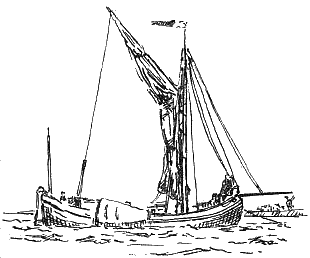 DUTCH
PROTOTYPE OF THE BARGE DUTCH
PROTOTYPE OF THE BARGE
He shows an utter lack, surprising in
such a mind, of that appreciation of fen and lowland
country scenery, which has given modern art much of its
landscape inspiration. He perceives not the wide skies
dear to the heart of the fenman ; he is impatient with
the short waves which those who navigate in tidal
estuaries must put up with. He forgets that the
sailing-craft of that day was high pooped and was
beflagged beyond modern wont, and he misses their
historic accuracy. Surely Van der Velde, of all masters,
had that 'high instinct of momentary perception' which
the great critic declares to be necessary to the drawing
of a sailing-boat?
Nor will criticism of the shallow
impurity of the seas depicted by the Dutch painters avail
if Turner's seas are to be accepted. For Turner followed
the Dutch School as much in painting the sharp, short
seas of shallow tidal coasts as in his studies of craft,
in which, as in 'The Shipwreck,' the influence of the
Dutch School is most marked.
SCHUYT
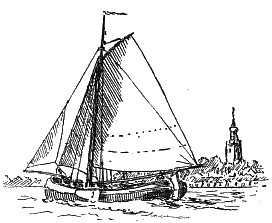 Ruskin
lived only to see his own sixth or 'modern' period of
marine painting ; he did not know that later, or seventh
period, as we may call it, which must always be famous to
all lovers of wild, true nature in the works of Wyllie,
Dixon, Somerscales, Napier Hemy, or of Blacke and his
compatriot Andersen. Ruskin
lived only to see his own sixth or 'modern' period of
marine painting ; he did not know that later, or seventh
period, as we may call it, which must always be famous to
all lovers of wild, true nature in the works of Wyllie,
Dixon, Somerscales, Napier Hemy, or of Blacke and his
compatriot Andersen.
To this school belongs the honour of
having rescued art from an untrue conception of the sea,
and having demonstrated the presence of law and order
upon the water as upon the land. By the aid of modern
shipping they have interpreted the sea's moods, its toil,
its fickleness, its glory and its strength ; by truth and
by study they have set forth as the old Dutch masters of
the seventeenth century essayed to do, and so well did,
through the medium of the Dutch craft of that
day.
Homage to Turner is yet possible to
the man who seeks for truth to Nature's laws in all
painting of the sea ; for wild as was his imagination,
truth lay in his wind, and his craft were always
possible, even if canvased at times in a way to strike
terror to the average coastwise skipper. He was curiously
unequal in his delineation of vessels, his square-rigged
ships showing a general accuracy of drawing and
understanding of sea matters which often seem quite
absent in his fore-and-afters. But these faults are more
apparent in his engravings than in his paintings, where
they are redeemed by the magnitude of his conceptions.
The back wave off his Calais Pier, the down-river light
in his Blythe sand, so true to those wide eastern
estuaries of Britain, are interpretations which must be
appreciated by all sailors. His general influence in the
direction of accuracy has been too much ignored by his
admirers, and but for the modern sea-school of Wyllie we
should still be immersed in untruth and clumsiness in all
our seascapes, notwithstanding the assistance of
photography towards accuracy in the delineation of
certain phases of sea life.
The distinctiveness of Dutch craft is
not less marked than that of the Chinese. Even to the
artist, often so blind to nautical facts, many of the
Dutch characteristics are frequently apparent. The great,
commanding-looking rudder, the round, merry-looking bow,
the comfortable tumble-house of the topsides, the tall,
splendidly proportioned pole-mast and the long vane at
its summit, the short gaff and long boom, the bright
colouring and spotless polish -- all these are as much a
part of Dutch scenery to the majority of minds as are
lock-gates or windmills. The whole has an aspect of
old-world incompetence and picturesqueness which is
utterly fascinating.
BOATS AT HAARLEM
(FROM A SKETCH BY E.W. COOKE)
Yet in fact, in that
slow-looking ship, the Dutchman possesses a combined
floating home and cargo carrier which is second to none
in handiness, smartness, comfort, and speed in the waters
she navigates.
Among the more familiar types are the
Eel schuyts and the Scheveningen pinken. The former have
been beautifully delineated by E.W. Cooke, and their
appearance is well known to Thames estuary yachting men.
They are perhaps the most representative of Dutch
sea-going craft. They carry the usual short gaffed
mainsail, setting an infinitesimal jib-headed topsail
above it. The main boom plumbs the stern-post, thus being
securely out of the way for passing through locks and
pushing through crowded inland waterways. Everything on
board a Dutchman is calculated with reference to the
necessities of inland navigation. The bowsprit is a
running one, and the huge stay foresail is ample
head-sail for ordinary work where quick turning is
required.
ON THE MAAS
The stout rubbing strakes, which to
the unaccustomed eye give such an appearance of
clumsiness, enable a schuyt to jostle her way into the
most crowded quarters with delightful impunity. The short
gaff itself is a concession to riparian owners ; this
bringing of the centre of effort of the sail-area low
down prevents excessive heeling and saves many a farm
window and many a pensive cow from unceremonious
annihilation. Partly with the same object, and partly to
counterbalance the want of depth of hull, the Dutchman
has adopted the great beam, which is perhaps to the
ordinary mortal his most marked characteristic. The
rounded stern with stern-post and rudder outside is,
except in some smaller boats such as small coast pinken,
almost invariable ; and any one who has been through many
lock-gates in a craft with a long counter will appreciate
the value of this style of build.
TURF BOAT
The Dutchman is enamoured, and rightly
so, of the full round curve, and has rarely descended to
that ugly though admittedly useful method of ending a
boat, the transom-stern. With exquisite taste he so uses
his white paint about the great varnished rudder-head,
and his green round the little stern-ports, that the
stern of his ship is generally a thing of beauty indeed.
But this form of round stern, with the heavy quarters and
the bluff bow, although adding to the carrying capacity
of the vessel, greatly increases her appearance of beam,
and makes her look more clumsy than she really is. As in
the case of the Chinese junk, however bluff or unwieldy
the upper works appear, the underwater lines are
generally very 'sweet,' and Neptune, to his credit be it
said, has ever a soft heart for a full sweet
curve.
PINK -- OPEN BOAT
SCHEVENINGEN
The solidity and strength of Dutch
construction is positively refreshing in these days of
light scantlings, and the fashion of polishing the oak of
the hull adds greatly to the impression of power in these
vessels.
The Scheveningen boats are
clinker-built and have the characteristics of Dutch craft
almost to the extent of caricature. But going to sea or
landing in the surf on that cruel coast call for a bit of
good construction. It is noticeable that many of these
boats carry a small mizen which is the peculiar sail of
sea-keeping craft, and this sail, as might be expected,
is never seen inland.
The old-fashioned 'galliot' was
similar in construction and was generally rigged as what
we now mostly designate a ketch, *1* but carried in
addition to the modern fore-and-aft sails the older
square topsail, t'gallantsail, and course on the
foremast, as very many Baltic ketches do to this
day.
PINK OR DUM
SCHEVENINGEN
The rig appears to have developed in
two directions: by the gradual enlargement of the mizen,
and the bringing of the mizen-mast further forward, until
the sail assumed the proportions of mainsail, from which
comes the modern topsail schooner so familiar among the
small traders of our coasts ; and in the other direction
by the gradual abolition of the square yards, leaving
only the fore-and-aft sails of the modern ketch, or
dandy, with the possible retention of a lower yard only
for a lower squaresail, the superior advantage of which
over a fore-and-aft sail for fair winds is admitted by
every sailor.
*1* The Old French quaiche ; the Spanish
queche.
The gradual development in both
directions may yet be seen in all stages upon the Dutch,
German, and Danish coasts, *1* while the results are more
distinctly apparent along our own shoreline.
DUTCH GALLIOT
(AFTER E.W. COOKE, R.A.)
The topsail schooner has assumed with
us something of the nature of a national rig for our
small coasters, while the ketch has become equally
distinctive as the rig of the British trawler *2* and of
the billyboy, a type of flat-bottomed, leeboard-carrying
coast trader.
*1* Chapter I.
*2* Chapter V.
The very commonest of the former is
apt to find one to its merits, but it is in fact the best
combination of the square rig with the fore-and-aft which
exists, and it presents all the advantages of
each.
EAST COAST LEEBOARD DANDY OR BILLY-BOY
• • •
YANKEE SCHOONER
The lower sails being of the
fore-and-aft type, a deck-watch of two hands will suffice
in ordinary weather to put about a vessel of 200 or 300
tons, and make and shorten sail ; the square topsail and
topgallant sail on the foremast are not too large to be
also easily handled by one or two men, and are big
enough, especially with the big fine-weather course, to
add many knots to every watch with the wind anywhere
abaft the beam.
TOPSAIL SCHOONER
The advantage of a squaresail placed
high up on the foremast in running before anything
approaching a gale of wind with a heavy sea is well known
to most sailors.
It seems peculiar that in America,
where the best development of the fore-and-aft schooner
rig is to be seen, the square topsail never seems to have
been in much favour.
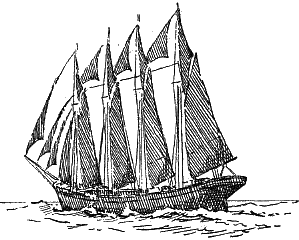 YANKEE
FOUR-MASTER YANKEE
FOUR-MASTER
While on this side of the Atlantic the
three-masted schooner and the barquentine are increasing
in popularity, and the square-rigged foremast is made a
great feature, in America the number of masts increase
until five (and even seven) masts are reached, and never
a square sail is seen aloft.
Yet it cannot be said that the
Americans do not know what is best in schooner-building
and rigging ; the high-flaring bow, the sail-carrying
power of the wide quarters, the tall lower masts, long
main-boom, and short gaff which are so distinctively
American, also combine to make schooners the like of
which we do not know.
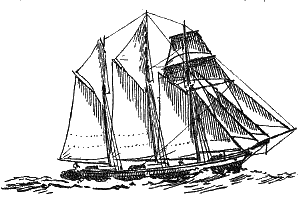
THREE-MASTED SCHOONER
• • •
HALIFAX SCHOONER-WINTER RIG
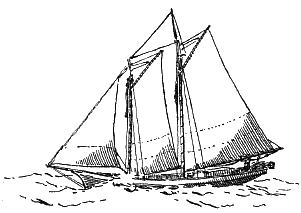
Yet it is probably the old story, that
each is suited to its own waters ; the very length of the
lower masts and weight of boom in the American boats may
be strong arguments against further weight from square
yards being stationed permanently aloft, while the more
moderate-sized spars used round our stormy coasts may
render such top-hamper harmless, and even, as already
hinted, of positive advantage four times out of five in a
strong blow.
RUSSIAN THREE-MASTER
The Russians have followed the Yankees
to some degree in adopting the fore-and-aft rig for
vessels carrying even three masts, and many vessels of
this type may be seen in the Baltic, as a rule neither
remarkable for smartness or sailing qualities in the
hands of the crews who man them.
BARQUENTINE
The advantage of the fore-and-aft rig
combined with squaresails on the foremast is every day
more apparent in the increasing number of three-masted
schooners and barquentines which are used in our
coasting-trade, and which, like the brigantine, are a
development of the topsail-schooner sail plan on larger
craft.
In this connection no sea fact is more
remarkable than the total disappearance of the brig-rig
for small coasting-craft: Turner, Cooke, and all coast
artists of the earlier part of the nineteenth century
bear witness to the universal adoption of this rig along
the coast, especially in the coal trade ; and in all
early views of the Thames these vessels, with the big
single topsail and topgallant sails and their enormous
fore t'gallant staysail, form a conspicuous
feature.
They have departed before the superior
handiness of the fore-and-aft sail for weatherly
work.
OLD COLLIER BRIG (AFTER
E.W. COOKE, R.A.)
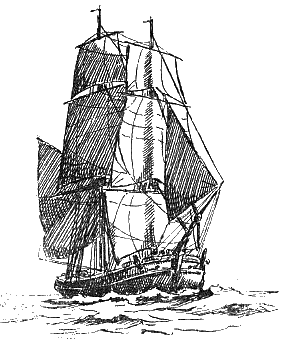 In
the other direction, that of the ketch, the Dutch appear,
as already remarked, to have set the fashion for this
very handy rig in the Baltic and North Sea. It is seen in
the Zee schuyts of the seventeenth century, and in our
own and other navies for bomb vessels, in those days with
squaresails on both masts ; and though it went out of
fashion during the first half of the nineteenth century,
the fore-and-aft ketch or dandy-rig of today may be said
to be the rig par excellence of the North Sea. Not only
the Danish coasters, but those of our own isles, use it
extensively ; practically the whole of the trawling
fleets of the North Sea, of whatever nationality, have
adopted it. It is curious to note in this connection that
our east coast fishing-craft, hailing south of the
Humber, which only thirty years ago favoured the lugsail,
have almost without exception altered to the ketch, or
'smack-rig,' as it is now often called. In
the other direction, that of the ketch, the Dutch appear,
as already remarked, to have set the fashion for this
very handy rig in the Baltic and North Sea. It is seen in
the Zee schuyts of the seventeenth century, and in our
own and other navies for bomb vessels, in those days with
squaresails on both masts ; and though it went out of
fashion during the first half of the nineteenth century,
the fore-and-aft ketch or dandy-rig of today may be said
to be the rig par excellence of the North Sea. Not only
the Danish coasters, but those of our own isles, use it
extensively ; practically the whole of the trawling
fleets of the North Sea, of whatever nationality, have
adopted it. It is curious to note in this connection that
our east coast fishing-craft, hailing south of the
Humber, which only thirty years ago favoured the lugsail,
have almost without exception altered to the ketch, or
'smack-rig,' as it is now often called.
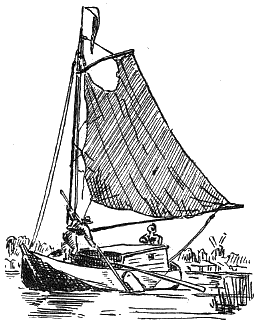 SWIM
HEAD EEL CATCHER SWIM
HEAD EEL CATCHER
Even Whitby has followed the fashion,
and Grimsby also. Yarmouth and Lowestoft were, when
Houldsworth wrote, well known for their fine lug-rigged
boats ; yet now they and Ramsgate to the south, as well
as many channel ports on both sides, have adopted the rig
for trawling. What is the reason? First, the fore-and-aft
rig was found more convenient than the lug for heaving
to, as the trawler has to do for hours at a time, the
main tack being easily triced up and staysail laid aback.
Then the one mast of the old 'smack' went out in favour
of the two, with the short main-boom and easily handled
mizen. Every one who has sailed a ketch knows her
handiness for a small crew. And for this rig we may
largely thank the Dutch. As befits our stormy seas,
however, we have reduced the tall mizen of the Dutch or
Baltic ketch to a low pole-mast, which is not so handsome
looking, but is more to the purpose in our seas. It is
noticeable also that the short boom of the Dutch and
Baltic mizen has been considerably lengthened in British
seas to give that width of foot which is dear to the
British sailmaker.
AT HAARLEM
The 'swim,' a most primitive form of
bow, such as with little difference may be met with in
the rivers of Bengal or of Central Europe, as well as in
many Chinese sampans, in which naval architecture has not
progressed with particular rapidity (having remained
practically stationary for some thousand years), may
still be seen in the Botters at Haarlem and many places
in the canals, as well as in the eel boats, of which a
fleet is often to be met off Flushing. *1* In a vessel of
light draught this shape of bow is far less injurious to
speed than might be imagined, although in a short
head-sea it is inclined to slam, and light displacement
Dutch yachts of this build which are given a good
sailspread are particularly fast in narrow
waters.
A book might be written on the Dutch
boats of the day, and a rich reward awaits the man who
can devote himself to the study of them.
*1* I have seen one of these boats as far west as Hirst
Castle.

VLAARDINGEN
|
 EARLY
LUGSAILS
EARLY
LUGSAILS DUTCH
PROTOTYPE OF THE BARGE
DUTCH
PROTOTYPE OF THE BARGE Ruskin
lived only to see his own sixth or 'modern' period of
marine painting ; he did not know that later, or seventh
period, as we may call it, which must always be famous to
all lovers of wild, true nature in the works of Wyllie,
Dixon, Somerscales, Napier Hemy, or of Blacke and his
compatriot Andersen.
Ruskin
lived only to see his own sixth or 'modern' period of
marine painting ; he did not know that later, or seventh
period, as we may call it, which must always be famous to
all lovers of wild, true nature in the works of Wyllie,
Dixon, Somerscales, Napier Hemy, or of Blacke and his
compatriot Andersen.
 YANKEE
FOUR-MASTER
YANKEE
FOUR-MASTER

 In
the other direction, that of the ketch, the Dutch appear,
as already remarked, to have set the fashion for this
very handy rig in the Baltic and North Sea. It is seen in
the Zee schuyts of the seventeenth century, and in our
own and other navies for bomb vessels, in those days with
squaresails on both masts ; and though it went out of
fashion during the first half of the nineteenth century,
the fore-and-aft ketch or dandy-rig of today may be said
to be the rig par excellence of the North Sea. Not only
the Danish coasters, but those of our own isles, use it
extensively ; practically the whole of the trawling
fleets of the North Sea, of whatever nationality, have
adopted it. It is curious to note in this connection that
our east coast fishing-craft, hailing south of the
Humber, which only thirty years ago favoured the lugsail,
have almost without exception altered to the ketch, or
'smack-rig,' as it is now often called.
In
the other direction, that of the ketch, the Dutch appear,
as already remarked, to have set the fashion for this
very handy rig in the Baltic and North Sea. It is seen in
the Zee schuyts of the seventeenth century, and in our
own and other navies for bomb vessels, in those days with
squaresails on both masts ; and though it went out of
fashion during the first half of the nineteenth century,
the fore-and-aft ketch or dandy-rig of today may be said
to be the rig par excellence of the North Sea. Not only
the Danish coasters, but those of our own isles, use it
extensively ; practically the whole of the trawling
fleets of the North Sea, of whatever nationality, have
adopted it. It is curious to note in this connection that
our east coast fishing-craft, hailing south of the
Humber, which only thirty years ago favoured the lugsail,
have almost without exception altered to the ketch, or
'smack-rig,' as it is now often called. SWIM
HEAD EEL CATCHER
SWIM
HEAD EEL CATCHER
